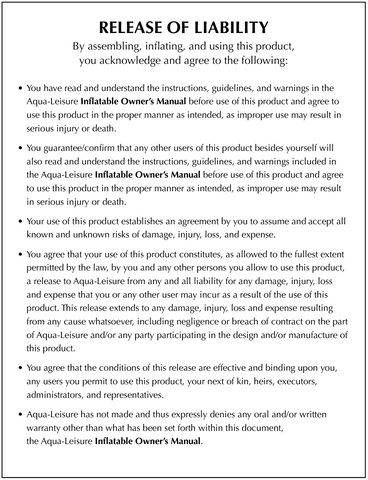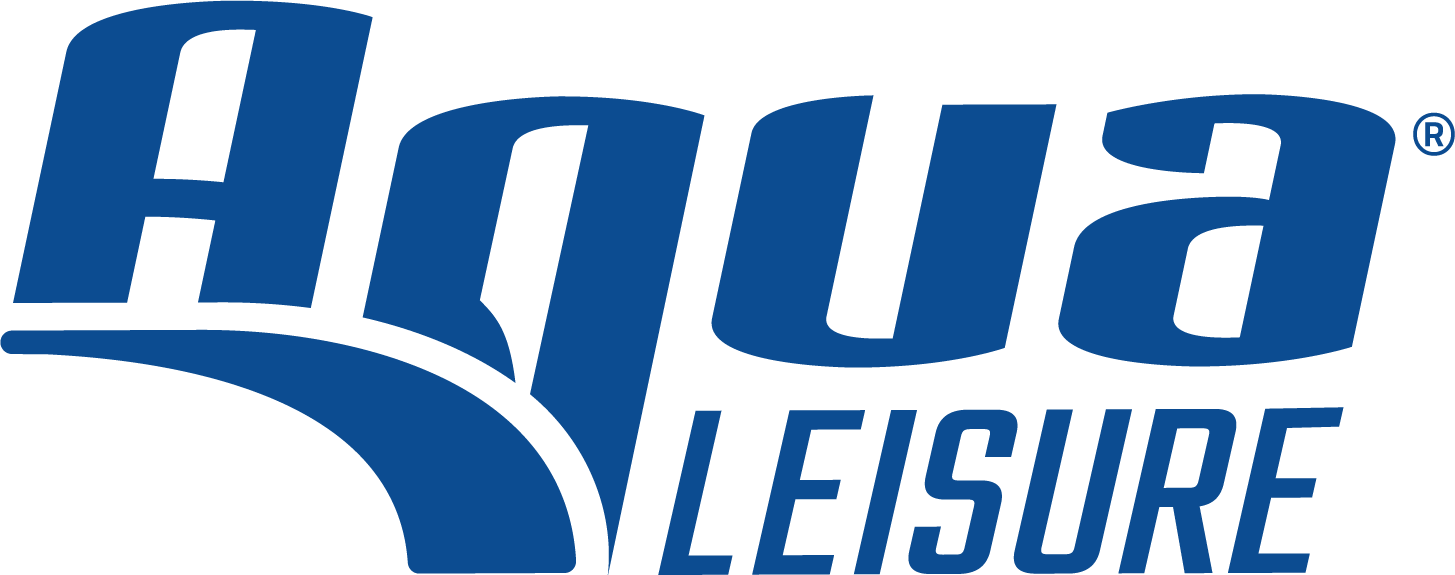INFLATABLE OWNER’S MANUAL
Water sports can be safe and fun for all levels of enthusiasts. This User’s Manual is intended to alert you to some of the potentially hazardous conditions that may arise during participation in all water sports. To prevent of SERIOUS INJURY or DEATH, follow these guidelines, the Water Sports Safety Code and the Water Sports Responsibility Code


WATERSPORTS SAFETY CODE
The warnings and practices in the Water Sports Safety Code represent common risks, but it is not intended to address all potential hazards associated with water sports. Please use common sense and good judgment.
Before you get in the water: Skiing or riding instruction is recommended before use. Instruction will teach general safety guidelines and proper skiing or riding techniques, which may reduce your risk of injury. For more information about skiing or riding schools, contact your dealer, association, or local ski club.
- ALWAYS familiarize yourself with applicable laws, waterways, and inherent risks. If you are not familiar with a waterway, ask someone who is, to tell you about any hidden dangers or other potential hazards to avoid.
- ALWAYS wear a properly fitted USCG type III / Level 70N, ISO/CE or other agency approved Life Jacket or Personal Flotation Device (PFD) whether you plan to be in a watercraft or skiing or riding behind one.
- ALWAYS inspect all equipment including, bindings, fins, tubes, other attachments, tow ropes and flotation devices before each use. DO NOT use if damaged.
Watercraft Safety: A knowledgeable, responsible and qualified driver is the most
important safety device on any watercraft.
- NEVER operate a watercraft, ski or ride under the influence of alcohol or drugs.
- ONLY use water ballast and people for additional weight. Uneven weight distribution or additional weight may affect the handling of your watercraft.
- NEVER exceed the passenger or weight limitations of your watercraft.
- NEVER allow passengers to hang outside your watercraft or towed device, to sit on the gunwales, or to sit anywhere outside of the normal seating areas.
- NEVER allow water to overflow the bow or gunwales of the watercraft.
Carbon Monoxide: Engine exhaust contains carbon monoxide (CO) which is a colorless, odorless and tasteless gas. Carbon monoxide is produced by burning fuel. Signs of carbon monoxide poisoning include nausea, headache, dizziness, drowsiness, and lack of consciousness.
To prevent SERIOUS INJURY or DEATH:
- ALWAYS avoid breathing engine exhaust. If you smell engine exhaust, move to fresh air.
- NEVER “platform drag” by holding onto the boarding platform or by dragging directly behind the watercraft.
- NEVER sit on the watercraft transom or boarding platform while the engine is running.
- ALWAYS make sure the engine is properly tuned and running well. A poorly tuned engine may produce high concentrations of carbon monoxide.
For more information, visit the United States Coast Guard website (www.uscgboating.org).
Tow Ropes: Tow ropes come in different lengths and strengths for different activities. Always check any rope you plan to use is intended for skiing or riding.
- ALWAYS inspect tow ropes prior to each use. NEVER use a damaged rope that is frayed, knotted, unraveling, or discolored from use or from sun exposure. REPLACE tow ropes with any sign of damage.
- ALWAYS use a rope with the proper tensile strength and follow all manufacturer’s recommendations for use.
- NEVER use a rope with elastic or bungee material as a tow rope to pull skiers or riders.
- ALWAYS attach rope in an approved fashion to your watercraft, using hardware designed for towing. Refer to your watercraft User’s Manual for instructions on proper tow rope attachment for each water sports activity.
- ALWAYS keep people and tow ropes away from the propeller, even when idling. Before retrieving a tow rope entangled with a propeller: ALWAYS turn OFF the engine, remove the key, and take the key with you.
- Tow ropes should be disconnected and safely stowed in the watercraft when not in use.
Preparing to ski or ride: ALWAYS have a capable observer in addition to a qualified driver, and agreed upon hand signals.
- ALWAYS check the driver is aware of the experience and the ability level of the skier or rider.
- The driver, the observer, and the skier or rider need to agree upon hand signals before skiing or riding. Signals should include READY, STOP, SPEED UP, and SLOW DOWN.
- ALWAYS check no one is in the water near the propeller before starting the engine.
- ALWAYS turn engine OFF when people are getting into or out of your watercraft, or are in the water near your watercraft.
- ALWAYS accelerate slowly to remove slack until the tow rope is taut after restarting your watercraft.
- When the skier or rider signals READY and states, “Hit it!”, confirm the path in front of your watercraft is clear of other watercraft or obstacles. Then accelerate in a straight line. Adjust your speed according to the signals given by the skier/rider.
Skiing or Riding: ALWAYS maintain a sufficient distance from the watercraft, the skier or rider, and any potential hazards, so a skier or rider falling or coasting and/or the watercraft will avoid potential hazards.
- ALWAYS wear a properly fitted USCG type III, ISO or other agency approved Personal Flotation Device (PFD) or Life Jacket.
- NEVER ski or ride near swimmers, shallow water, other watercraft, or obstacles.
- ONLY use on water.
- NEVER attempt land or dock starts. This will increase your risk of serious injury or death.
- The faster you ski or ride, the greater your risk of injury.
- NEVER make sharp turns while towing skiers or riders. Sharp turns may result in sudden acceleration of the skier’s or rider’s speed.
- ALWAYS tow skiers and riders at appropriate speeds for their ability level.
- Towing multiple skiers or riders increases their likelihood of injury.
Fallen skier or rider: ANY FALL may result in injury.
- ALWAYS circle fallen skier or rider slowly to return the tow rope handle or pick up the fallen skier/rider.
- ALWAYS put engine in neutral when near a fallen skiers or riders.
- ALWAYS keep the fallen skiers or riders in view and on the driver’s side of the watercraft.
- ALWAYS turn engine OFF when a skier or a rider is getting into or out of the watercraft or is in the water near the watercraft.
- ALWAYS display a red or orange skier-down flag to alert other watercraft that a skier or rider is down.
WATER SPORTS RESPONSIBILITY CODE
![]()
![]()
Be aware that good judgment and personal awareness can help
reduce the risks in boating and water sports.
To prevent SERIOUS INJURY or DEATH:
- ALWAYS familiarize yourself with applicable laws, waterways, and inherent risks.
- ALWAYS have a capable observer in addition to a qualified driver, and agreed upon hand signals.
- ALWAYS wear a properly fitted USCG type III / Level 70N, ISO/CE or other
- agency approved Life Jacket or Personal Flotation Device (PFD).
- ALWAYS inspect equipment before use. DO NOT use if damaged.
- ALWAYS ski and ride in control, at appropriate speeds for the conditions and within your limits.
- ALWAYS turn engine OFF when anyone is near watercraft power drive unit.
- ALWAYS make sure the engine shutoff lanyard is connected to the driver.
- ALWAYS avoid breathing engine exhaust. Move to fresh air if you smell engine exhaust to prevent carbon monoxide poisoning.
- NEVER “platform drag” or touch swim platform while the engine is running.
- NEVER ski or ride near swimmers, shallow water, other watercraft, or obstacles.
- NEVER operate watercraft, ski or ride under the influence of alcohol or drugs.
- NEVER accelerate watercraft if tow rope is wrapped around any body parts.


RIDER GUIDELINES
- Carefully read and familiarize yourself with this product manual.
- Be sure you know how to properly attach the tow rope and operate the towable before use.
- Do not attach any body part to the towable cover and never place hands or feet between cover and tube.
- Do not attempt any stunts or tricks as you increase the risk of injury when doing so.
- As this towable has no breaking or steering mechanism, it can develop high speeds under certain conditions.
- This product is for water use only—do not launch from dock or land.
- Do not use near docks, shore, or in shallow water.
- This product is not a life-saving device; do not use the towable as a personal flotation device—only use for its explicitly stated purpose.
- Do not exceed the recommended number of riders for this particular towable and do not tow more than one towable at a time.
- Never approach the propeller when the engine is running, even if the watercraft is in neutral.
- Only use this product with an experienced and responsible watercraft driver.
BOAT DRIVERS AND SPOTTERS
- A knowledgeable and responsible driver is the most important safety device on any watercraft.
- Know the waterways and always carefully survey the area before towing riders.
- Make sure engine is off when people are boarding or deboarding the watercraft or in the water near the watercraft.
- Always be aware of water conditions and upcoming weather changes.
- Never pull a towable without a rider as a towable is specifically designed to have a rider for balance of weight distribution.
- Do not tow in shallow water, near shore, pilings, docks, rafts, swimmers, other boats, or other obstacles.
- It is always the watercraft driver’s responsibility to ensure that all riders know how to ride a towable and to carefully instruct riders of all risks involved.
- Always have a person other than the driver present as a spotter.
- The spotter should hold up a safety flag cautioning off other boaters when riders are present in the water.
- Always remove any slack in the rope between watercraft and riders before starting.
- Wait until riders have signaled that they are ready before slowly bringing the towable to a planing point.
- Most towables plane out at 10 to 20 mph (16 to 32 km/h), depending on the weight of the riders. It is important to keep the nose of the towable up until towable is planing.
- The resistance of the towable will vary depending on the boat speed, turns,
- water conditions, weight and number of riders, towable shape, and size.
- The driver determines the speed of the towable during turns and when crossing watercraft wake.
- Large wakes combined with wave action and speed can contribute to a rougher ride. Always use a safe speed that ensures the towable is able to plane out.
- Under normal conditions, 20 mph (32 km/h) is the maximum safe speed for adults and speeds less than 15 mph (24km/h) are preferable for children, taking into account their age and physical capabilities.
- The towable speed will increase with 90 to 180 degree turns.
- Excessive speed and sharp turns may cause the towable to flip over abruptly.
- If the towable overturns, the driver should not exceed 5 mph (8 km/h) until
- the towable is upright.
- The spotter should use a flag to signal to others when a rider is in the water.
- The driver must use extra caution when approaching a fallen rider and keep eye contact on the fallen rider at all times.
- Driver should always put watercraft in neutral when near a fallen rider.
Caution for Boat Owners with High Tower and Pylons: Tow towers are not designed for use with any inflatable towable. Use only lifting eyes/transoms on the boat for towables with 2 or more riders. Do not tow any inflatable from a ski pylon or ski eye. Any tow pylons installed after-market are not intended for inflatable towables.



